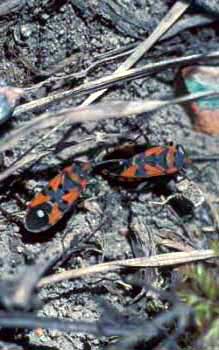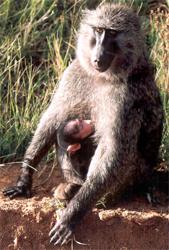Birgitta S. Tullberg
Professor of Evolutionary Ecology
.

- Myself

- A pair of warningly coloured bugs, Lygaeus equestris (Lygaeinae, Heteroptera).

- A polygynandrous baboon.
Aposematic coloration
My interests concern evolution and ecology. One research area is defence strategies in insects and the relationship between defence and other life history traits. Together with my collaborators I have done a lot of research trying to understand the evolution of warning (aposematic) coloration. Specifically, we have tried to answer the question how such a seemingly costly trait as bright coloration can evolve in a population. Through the combination of theoretical, experimental and comparative studies we have challenged the generally held notion that kin selection is important for the evolution of warning coloration. Further we have investigated the function of aggregation in aposematic insects and found that it may increase signal efficiency.
Mating systems
Another research area is the evolution of mating systems and related traits. In phylogenetically based comparative research we have studied how primate female oestrus signals are related to mating systems. We have been able to refute some hypothesis concerning the loss of such signals, while simultaneously finding support for the hypothesis that this is a female strategy to diminish negative effects of male-male competition. This study sheds some light on loss of oestrus signals in humans. We have also made a larger phylogenetic investigation of how size dimorphism has evolved in primates, by separating out size changes in males and females. We have found that not only does male size increase after a transition to a mating system with an expected increase in male-male competition, but so does female size, but to a lesser extent. We also made the interesting discovery that size increases were generally larger than size decreases in the phylogeny, which pattern may be responsible for a general size increase in a lineage. Several studies concern the evolution of mating systems and parental care in birds, and one interesting finding from this research is that polygyny evolves more often in lineages with precocial young.
Phylogenetic methods
Phylogenetic methods have been an important part of the above research areas, and I believe that my study on butterfly larvae in 1988 was one of the first to explore the great potential of using phylogenies to answer questions in evolutionary ecology. Over the last decade the field of phylogenetic ecology has exploded and I have certainly been interested in the philosophy behind various methods, specifically with regard to how phylogenies can be used to test various evolutionary hypotheses. I have also been involved in developing methodology, for instance concerning the investigation of continuous characters.
Normative ethics
I am also interested in the evolution of human behaviour and how it relates to normative ethics. This field of interest is more conceptual than empirical, and deals with the difficult question how norms could be made compatible with human behaviour as understood from evolutionary biology. One part of this work deals with classification of behaviour, and an important aim is to bring about coherence, especially with regard to the concepts of selfishness and altruism. One of our behavioural categories, group egoism, is dealt with in a paper on possible solutions to ethnic strife.
![]()